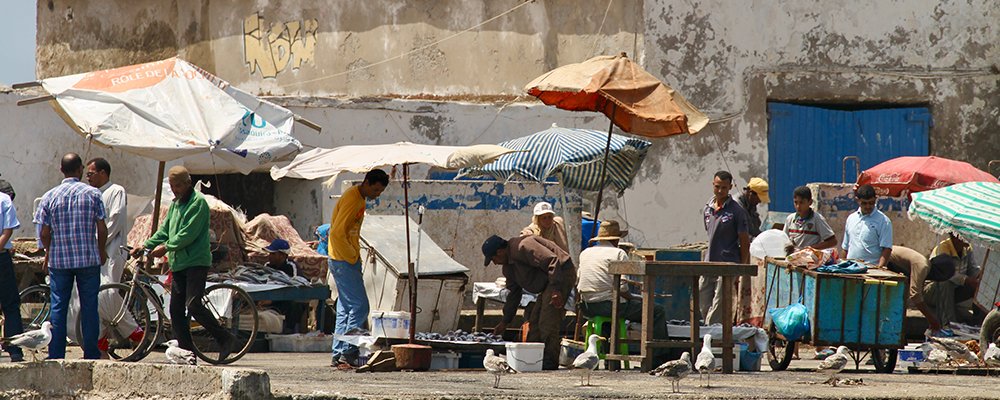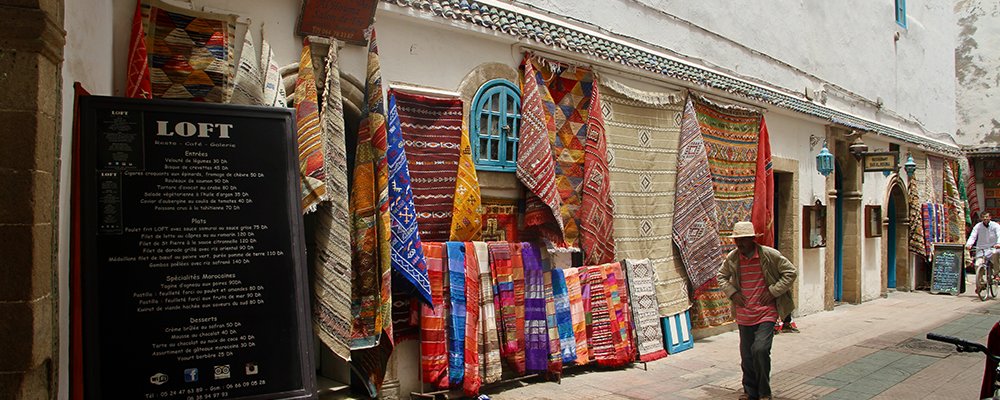An ancient Moroccan port city that's a mecca for windsurfers and surfers, Essaouira is where the coastal trade winds 'Alizee' blow, whipping up the waves to bash against the seafront ramparts, originally designed by European engineers. Nicknamed 'the wind city of Africa,' Essaouira is best to visit during September and October when the gusts and squalls of 'Alizee' drop to mere windy whispers, and it's possible to walk along the stunning beach bay without being choked on mouthfuls of sand. Occupied since prehistoric times, this beautiful fortified city is somewhat sheltered from the strong seas by the outlying Mogador Island, the main island of the small group of Iles Purpuraires, where originally Roman merchants settled in a small village.

The town is a cultural jumble; from the north came the Arab Chiadma, from the south the Haha Berbers and the Gnawa, then add in the early exploring Europeans and the wealthy foreign merchants encouraged to settle here when in the 1700s free trade policies were introduced by Sultan Ben Abdellah. This hoi polloi of humanity brought their own religions; Muslim, Jewish, and Christian. Once the hub for Morocco's worldly trade in exotic items such as ostrich feathers, almonds, ivory, and dried camel skins hauled across the sub-Saharan by Berber traders, Essaouira witnessed the growth in the English trade of cotton and tea courtesy of the established British traders now living in the city.

Essaouira, perched on the rocky seafront, has been known by numerous names over the centuries——Thamuziga, Karikon Teikos, Mogadouro, Amagdoul, Mogador, and Tassourt—and nicknames such as 'The Door to Timbuktu' and the 'pearl of the Atlantic.' Seagulls squawk in endless blue skies above massive brass cannons that are lined up like sentries on the top of the defensive walls. Below, fishermen haul in the early morning's catch, and boat-building craftsmen hone their craft on immense boats laid up on wooden dry dock contraptions in the salty air. These mammoth sea-going vessels appear like dead sea creatures marooned on stilts as they get their bellies scrubbed and painted. Craggy, weather-beaten faces of local men huddle around the jetty, mending nets under the shadow of walls. Looking out to sea are two small uninhabited islands named 'Îles Purpuraires' (Purple Isles). In the 5th Century BC, Hanno, a Carthaginian navigator, established a trading post here, and around the 1st Century AD, Juba II, a Berber prince, founded a Tyrian purple factory on the islands—the dye coming from mixing purpura shells and sea snails found in the rockpools of the shoreline. It was used in the making of purple sashes for Roman Senatorial togas. Today, these ancient islands are a protected haven for Elleonora’s falcons that can be seen soaring the wind thermals on long pointy wings.

The cool salty sea air does little to hide the briny smell of the seafood market on the concrete pier. Fishermen, hawkers, locals, and tourists gather en masse, some under haphazardly erected old umbrellas. Others cluster around rickety carts overflowing with sparkling fish still dripping from the seawater and glittering in the sun. When you cast your eyes to the opposite side of the fortress walls, the wide crescent-shaped beach with the hotel façade of Atlas Essaouira & Spa fills your vision.

 The town's spice-scented alleys meander in a brilliant white maze with richly textured rugs hanging from walls, an abundance of stacked vivid ceramic bowls, and striking jewelry pieces dangling beside an array of leather shoes in quaint doorways. Escaping the narrow lanes infused with the wafts of mint tea or the pungent aroma of coffee from cute cafes with eclectic décor hiding behind artful blue wooden doors decorated with forged iron, the sunny square of the French-designed medina dotted with tables and chairs opens up before you. Light-hearted laughter rings out from brown-skinned children cavorting in the open area as long robes billow around the bodies of turbaned men gliding across the hot pavement. The hurried flutter of older women wearing traditional djellaba scurrying into doorways or haggling in the street market play in your vision. Contemporary restaurants with stunning panoramic views over the ocean sit on rooftops with only a sign at the bottom of a winding staircase to lead you up into a chic domain where you can scoff traditional cuisine, specializing in the local seafood that makes your mouth water. It's the place to be when the sun slowly sinks to the horizon in a burst of red, yellow, and orange. There are art galleries, tempting boutiques to browse, and some luxurious hotels, such as stepping back in time with a bed in the Relais & Châteaux property, ‘The Heure Bleue Palais.'
The town's spice-scented alleys meander in a brilliant white maze with richly textured rugs hanging from walls, an abundance of stacked vivid ceramic bowls, and striking jewelry pieces dangling beside an array of leather shoes in quaint doorways. Escaping the narrow lanes infused with the wafts of mint tea or the pungent aroma of coffee from cute cafes with eclectic décor hiding behind artful blue wooden doors decorated with forged iron, the sunny square of the French-designed medina dotted with tables and chairs opens up before you. Light-hearted laughter rings out from brown-skinned children cavorting in the open area as long robes billow around the bodies of turbaned men gliding across the hot pavement. The hurried flutter of older women wearing traditional djellaba scurrying into doorways or haggling in the street market play in your vision. Contemporary restaurants with stunning panoramic views over the ocean sit on rooftops with only a sign at the bottom of a winding staircase to lead you up into a chic domain where you can scoff traditional cuisine, specializing in the local seafood that makes your mouth water. It's the place to be when the sun slowly sinks to the horizon in a burst of red, yellow, and orange. There are art galleries, tempting boutiques to browse, and some luxurious hotels, such as stepping back in time with a bed in the Relais & Châteaux property, ‘The Heure Bleue Palais.'

Essaouira reeks of its turbulent history when marauding pirates would come ashore, Europeans would hustle around, and the windswept cove bustled with the trade of slaves, sugar, and molasses. It's no wonder that Essaouira was the setting for the city of Astapor, home of the Unsullied, in the 'Game of Thrones' series. With a charming bohemian vibe where surfing and solitude are drawcards, Essaouira has attracted numerous music legends: Frank Zappa, Cat Stevens, Bob Morison, The Rolling Stones, and apparently Jimmy Hendrix has been the town’s tart, supposedly sleeping in everyone's house—according to local gossip.
Gail Palethorpe, a self proclaimed Australian gypsy, is a freelance writer, photographer and eternal traveller. Check out her website Gail Palethorpe Photography and her Shutterstock profile.















